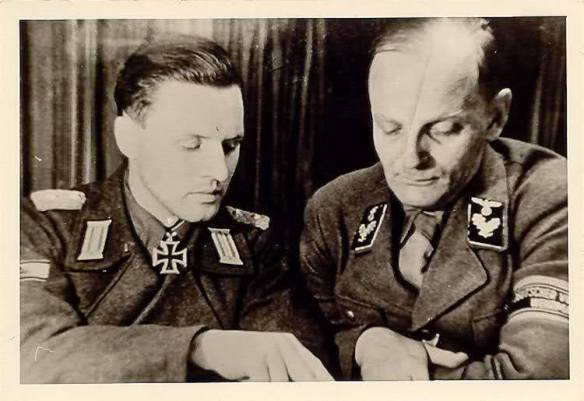
On the left – Oberst Remlinger
Schneidemühl [the name today is Pila (pronounced Piwa) ]was the “cornerstone” of the defence of East Pomerania. The garrison of Schneidemühl was commanded by Colonel Remlinger, and some particularly heavy fighting developed against the troops of the 47th Soviet Army in the extensive railway marshalling yards. A German armoured train operated to very good effect, and it managed to retrieve a whole train loaded with ammunition and supplies from under the noses of the Soviets. Nevertheless Schneidemühl fell on 14 February when the garrison broke out. Only a thousand men got through and all the rest were killed or captured over the next few days.
The town of Schneidemuhl had 45000 inhabitants in January 1945.It was an important crossroad and railway center, so it was chosen by Hitler to be a “Strongpoint” (Wellenbrecher). There were two military airfields and the important Albatros Werke who fabricated parts for ME 262 jets. It’s unlikely that there were jets stationed on the airfields for that area was under responsibility of Luftflotte 6 and they had no jets.
Only at 24 January started the evacuation of the civilian population. Soviet shells fell already in the town. The party officials had held up the evacuation until the last moment. Trains were send from Deutsch Krone ( 15 miles north) but there weren’t enough, so many people left the town on foot or by cart. Temperature was about -25 c. and snow piled up to 50 cm. The journey became a nightmare. Meanwhile remnants of the 2eGerman Army were fallen back to the north and west and could do little except attempt to avoid destruction. Elements of a newly formed Amy Group called Army Group Vistula appeared under command of Himmler. Von dem Bach Zelewsky commander of the X SS Corps that defended the area of Schneidemuhl proposed to give up the town to make the front shorter but Himmler insisted in defending the town.
Commanding officer was Oberst Remlinger, he had about 12000 men to his possession A pioneer battalion and anti-tank units from the 71e inf. div., 4″Gneisenau”battalions(weak) 8 fortress battalions( also weak)plus some Sturmgeschutze and modern anti-tank guns but I don’t know the types or the number. There was enough food in the town, for some bakeries and butcheries were kept running. Munitions was another story. On 24 January 2 Guard Army and 5 Shock Army started their attack on Pomerania. In very cold weather and on snow and ice covered roads the Soviets made little progress. But this was not completely due to bad weather conditions. Excessive looting and consumption of liquor found in farms resulted in deterioration in discipline. 30% of 5 Shock Army were no longer obeying orders.
Only at 31 January was Schneidemuhl completely surrounded. Much fighting was centred around the railroad yards where both sides tried to retrieve provisions left behind by the panicked flight of the civilian population. The Germans had a very useful armoured train there that kept the mostly drunk Soviets at a distance. Slowly the Soviets pushed the defenders in the inner city. Ju 52`s operating from Koslin and Stolp flew in munitions and provisions. They evacuated 1026 wounded soldiers and 215 civilians. In the beginning of February the German front had fallen back and a relieve attack seemed impossible.
After 12 February aircraft could no more land in the town and munitions ran out. So Oberst Remlinger decided to break out. He knew he would never get authorisation for that from Hitler or Himmler and so he went on his own responsibility. On 13 February the defenders broke out in three groups. With help of the last surviving three Sturmgeschutze and the armoured train they broke through the Soviet ring. They did not get very far, every group was shot up outside the town and the survivors had to reach the German lines which were some 30 to 40 miles away.
They hid in the countryside for weeks, sometimes mixing up with broken out survivors from the fortress Posen (which had fallen on 23 February) The Soviets hunted them down and killed everyone they could get. About 1000 reached the German front but Army Group Vistula reported only 186. They left behind civilians (15000 to 18000 people) to their fate. On 23 February Soviets and Poles entered the town and murder, rape and looting started as in the Middle Ages.
Sources: Russo German War no. 34/35 Victor Madeja Pommern /Helmut Lindenblatt Die Eroberung Pommern /Erich Murawski